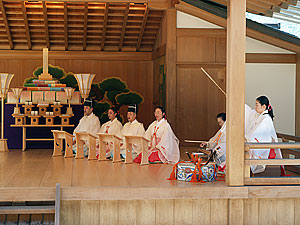Kamishima Cleanup
Harima branch members regularly visit this sacred island to keep the shrine tidy
By Bill Roberts
On Oct. 4, 1916, about 100 Oomoto followers led by Foundress Nao Deguchi and Co-Founder Onisaburo Deguchi, sailed to Kamishima, a small uninhabited island seven miles southwest of the town of Takasago in the Inland Sea of Japan.
There they enshrined the god of the island, Hitsujisaru no Konjin (God of the Southwest). The visit would prove to be a pivotal moment in the early history of Oomoto.
Led by the Spiritual Leader, Oomoto followers return to Kamishima every five years for a service, the most recent in 2006. But four times a year, members of the Harima branch, which is responsible for the shrine’s upkeep, visit to tidy up and make improvements.
On July 22, 2007, I accompanied the Harima members for their mid-summer cleanup. There were 17 of us on a hazy, sultry day when not the slightest breeze stirred.
We departed around 8 AM, crossing a smooth sea and making landfall about 30 minutes later. At this time of year, the island is surrounded throughout the day by fishing boats, water skiers, divers and mid-summer frolickers.
A steep stone stairway leads to a pine grove on a shoulder of the island where the shrine sits. An unmanned lighthouse sits on top of the island a few hundred meters farther up. There are no other structures.
The shrine used to be a rock building, but the Japanese government destroyed it during the second suppression of Oomoto (1935-1945). You can still see the pieces of stone that were dynamited. Under Sumiko Deguchi, the Second Spiritual Leader, Oomoto decided not to rebuild the shrine after the suppression ended, but used the broken stone to terrace the site. They also erected a special stone with calligraphy by Sumiko, stating: “Miroku no O-Kami” – The Great God of Miroku.
Nao and Onisaburo led early Oomoto followers on several pilgrimages during Oomoto’s first quarter century. Most of these were on instructions Nao received from Ushitora no Konjin, the god who was telling her what steps Oomoto must take to lay the groundwork for the reconstruction of the world.
Kamishima has the distinction of being the only of these pilgrimages that was launched because god spoke through Onisaburo in a vision, according to the book, “Nao Deguchi: A Biography of the Foundress of Oomoto.”
Onisaburo, Nao’s brash son-in-law, was distrusted and even ostracized by some Oomoto followers in the early years. Within a couple of days after the visit to Kamishima, Nao learned through her automatic writing (dictated by Ushitora no Konjin) why Onisaburo had been sent to Oomoto: He was the spirit of Miroku, the savior who would usher in the new age. From that time on, Nao knew that her son-in-law would carry on the work for the reconstruction of the world after she was gone.
The trip to Kamishima has the distinction of being the last of the many pilgrimages Nao made. She passed away about two years later in November 1918.
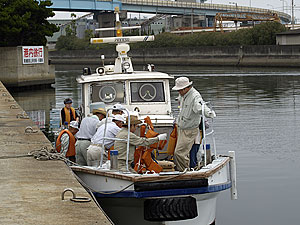
Harima members load the boat for Kamishima.

Kamishima looms in the distance.
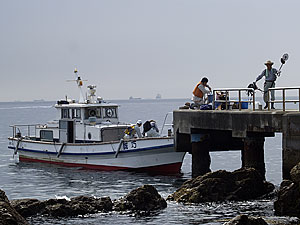
Work party disembarks on the island.
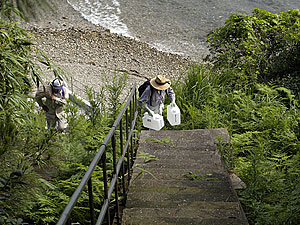
Workers mount steep stairway to the shrine.
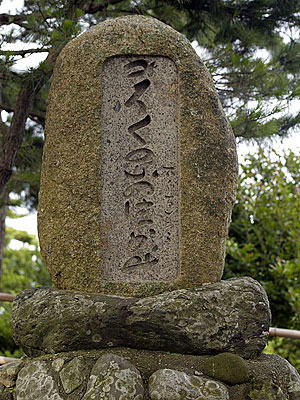
The shrine is a simple stone with calligraphy.
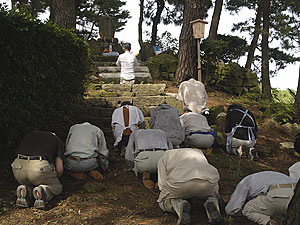
Before starting to work, the crew prays.
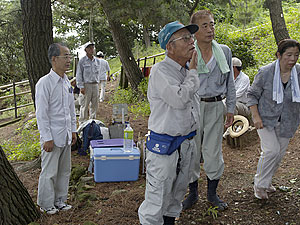
Then they take stock of matters.
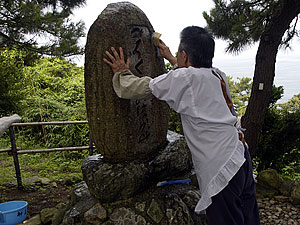
The women undertake the most important part – cleaning up the stone.
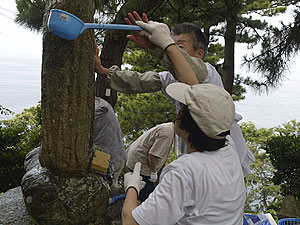
Water for this cleanup was carried from the mainland.
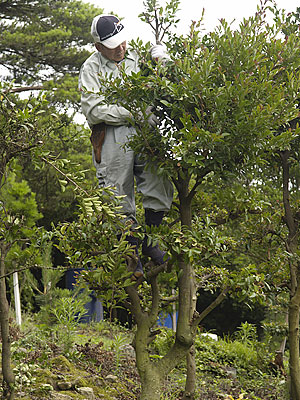
The men undertake gardening chores; if left untrimmed the site would soon be a jungle.
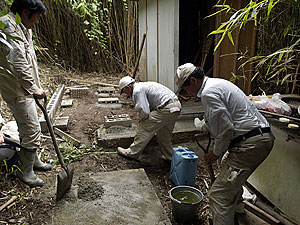
A special project on this visit was laying a foundation for a larger storage shed; we carried sand from the beach for this.
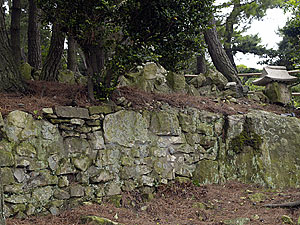
Broken stones from the original shrine, destroyed in 1935, were used to terrace the site.

Broken stones from the original shrine, destroyed in 1935, were used to terrace the site.
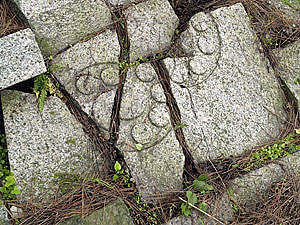
Broken stones from the original shrine, destroyed in 1935, were used to terrace the site.
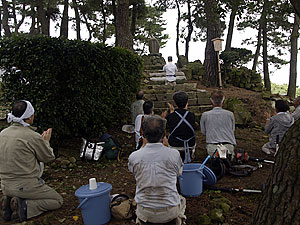
A prayer before we depart at the end of a long hard day.
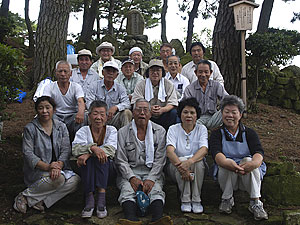
The work crew.
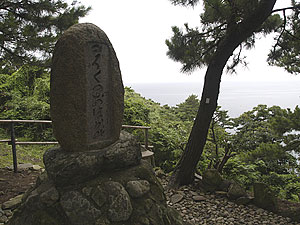
One last look.
New Contents Thu, May 20, 2010
- Oomoto participates in Sant’Egidio conference : Dialogue among religions and cultures : On divided island nation of Cyprus By Bill Roberts
- Photo Album : Portraits of three branches: Shoko, Tanegashima and Aomori By Bill Roberts
- Oomoto FAQ
- A Letter from Oomoto : Of mountains and myths By Bill Roberts
- Polyglot poem festival The Utamasturi is going international — what’s next? By Bill Roberts
- Ethics education program captures the spirit of Bankyo Dokon By Bill Roberts
- A Letter from Oomoto : A year’s worth of adventure in a summer of branch visits By Bill Roberts
- In Kumamoto, it’s all about water – and fire By Bill Roberts
- A speech by Nevada Taylor at the Kii Branch in Wakayama Prefecture on April 13, 2008.:An Encounter With Oomoto Through Aikido
- Utamatsuri, Poem Festival, in Tokyo(on April 17, 2008)
- A speech by Neil Ryan Walsh at the Kobe branch on Mar. 9th, 2008.:Planting the Seeds of the Soul
- Meeting with the Fifth Spiritual Leader of Oomoto, Madame Kurenai Deguchi by Neil Ryan Walsh
- A speech by Neil Ryan Walsh at the Nagoya branch on Feb. 17th, 2008.:The Japanese Arts beyond National Boundaries
- To the Oomoto branch in Nagoya: City of Eel and Toyota by Neil Ryan Walsh
- A Speech by Nissim Ben Shitrit, Ambassador of Israel on the occasion of the Oomoto Setsubun Grand Festival in Ayabe February 3rd, 2008 : Japan and Israel : Two Lands Balancing the Needs of Traditional Culture and Modern Life. r
- A permanent memorial to Onisaburo (A Speech at the Autumn Grand Festival , November 6, 2007 : )By James Parks Morton, Founder and Chair, Emeritus of The Interfaith Center of New York
- Israel, Palestine and the Power of Poetry(Oomoto believes small efforts can have lasting ripple effects on people and peace)By Bill Roberts
- “Something Great”(This genetics pioneer, a friend of Oomoto, offers a clue to the mystery of life)By Bill Roberts
- Kamishima Cleanup (Harima branch members regularly visit this sacred island to keep the shrine tidy)By Bill Roberts
- Kyotaro Deguchi was one of six recipients of the 2007 James Parks Morton Interfaith Award
What is Oomoto?
- What is Oomoto?
- Spirtual Centers
- Founders and Spiritual Leaders
- History
- Organization and activities
- Teachings and scriptures
- Art Works of Founders and Leaders
Opinions[Archive]
- Statement of regret for the outbreak of war against Iraq (March 20,2003)
- Jinrui Aizenkai dispatched the "Urgent Appeal for a World (Global) Crisis" on March 14.
Grappling with Bioethics[Archive]
- Oomoto’s support for abolishing the death penalty (12, June 2003)
- The Oomoto Foundation protests any birth of a human clone baby. (5, January 2003)
- OOMOTO'S VIEW REGARDING JAPAN’S PERMITION TO THE RESERCH OF HUMAN EMBRYONIC STEM CELLS (ES cells)(12, June 2000)
Vistor’s Review[Archive]
- A speech by Bill Roberts at the Oomoto branch in Hiroshima after its monthly service on March 18, 2007:Encounters with war and peace
- How Bankyo Dokon changed one life by Linda Macphee
- A speech by Bill Roberts at the Hokuriku (Kanazawa) branch on Dec. 3, 2006:Ritual and myth -an encounter with ‘divine madness’
- A speech by Bill Roberts at the Himeji Cultural Center on Feb. 25, 2007:Mesmerized by the Japanese Arts
- A speech by Bill Roberts at the Kobe branch on Feb. 11th, 2007.:There are just human tears and human joy
- A Speech on the occasion of the Oomoto Setsubun Grand Festival in Ayabe February 3rd, 2007 : Egypt's role in Middle East peace
- Keynote Speech for the 28th World Federation Japanese Religionists Conference for World Peace in Tokyo (at Kokugakuin University, Novermber 29, 2006):Vision for Peace in the Middle East By Dr. Munther S. Dajani, Professor Dean, Faculty of Arts, Al Quds University, Jerusalem
- A speech to the Kyoto branch:Spiritual adventures in researching Oomoto leaders
- A Speech at The Oomoto Foundation on Monday, November 6, 2006 : Jordan's role in Middle East By Samir Nouri, Ambassador of the Hashemite Kingdom of Jordan
- A letter from Oomoto:The Young People of Tottori
- A speech by Bill Roberts on the occasion of the dedication ceremony for the new shrine of Tottori Branch By Bill Roberts Oct. 8, 2006
- A speech by Bill Roberts at the Oomoto branch in Hiroshima after its monthly service on March 18, 2007:Encounters with war and peace
- How Bankyo Dokon changed one life by Linda Macphee
- A speech at Setsubun : A Portrait of Oomoto By Bill Roberts Feb. 3, 2006
- New Publication ! By Bill Roberts Feb. 3, 2006 A Portrait of Oomoto
you can read this book in html => http://www.jinruiaizenkai.jp/English/en-kolumno/en-bill/en-sugao/billbook1en.html
E-mail below to order brobert1@ix.netcom.com
Current Topics
- Prayer Offering and World Religious Forum II
- Living the art of dialogue
- Kyotaro Deguchi was one of six recipients of the 2007 James Parks Morton Interfaith Award
Books
Online Books
- Divine Signposts by Onisaburo DEGUCHI
- The Creation of Meaning by Hidemaru Deguchi
- Bankyo Dokon(Seventy years of Inter-Religious Activity at Oomoto)
- Nao Deguchi — A Biography of the Foundress of Oomoto
- The Great Onisaburo Deguchi published by Aiki News
- Bankyo Dokon Seventy Years of Inter-Religious Activity at Oomoto
- Insearch of Meaning
- Nao Deguchi A Biography of the Foundress of Oomoto
- A Portrait of Oomoto By Bill Roberts
Oomoto international Archive
- The History of Oomoto (Jan.– Mar. 1980 — Apr.– Jun. 1982)
- The Ancestors; Friends or Foes? (Apr.– Jun. 1987)
- Tsukinamisai; The Sabbath of Shinto (Jan.– Jun. 1983)
- The Poem Festival at Oomoto; An Ancient Rite Lives Again (Oct.– Dec. 1981)
- Purification of the Universe ; Oomoto's Setsubun Festival (Apr.– Jun. 1981)
Links
Flowers at Ten'on-kyo & Baisho-en (photographs)
Contact
All rights reserved : the Oomoto Foundation Produced by the Netinformational Commission
Since : Mar. 7.1998 Last Update : Thu, May 20, 2010
E-mail : webmaster@oomoto.or.jp
Top Page Nihongo Esperanto Português Roomazi



